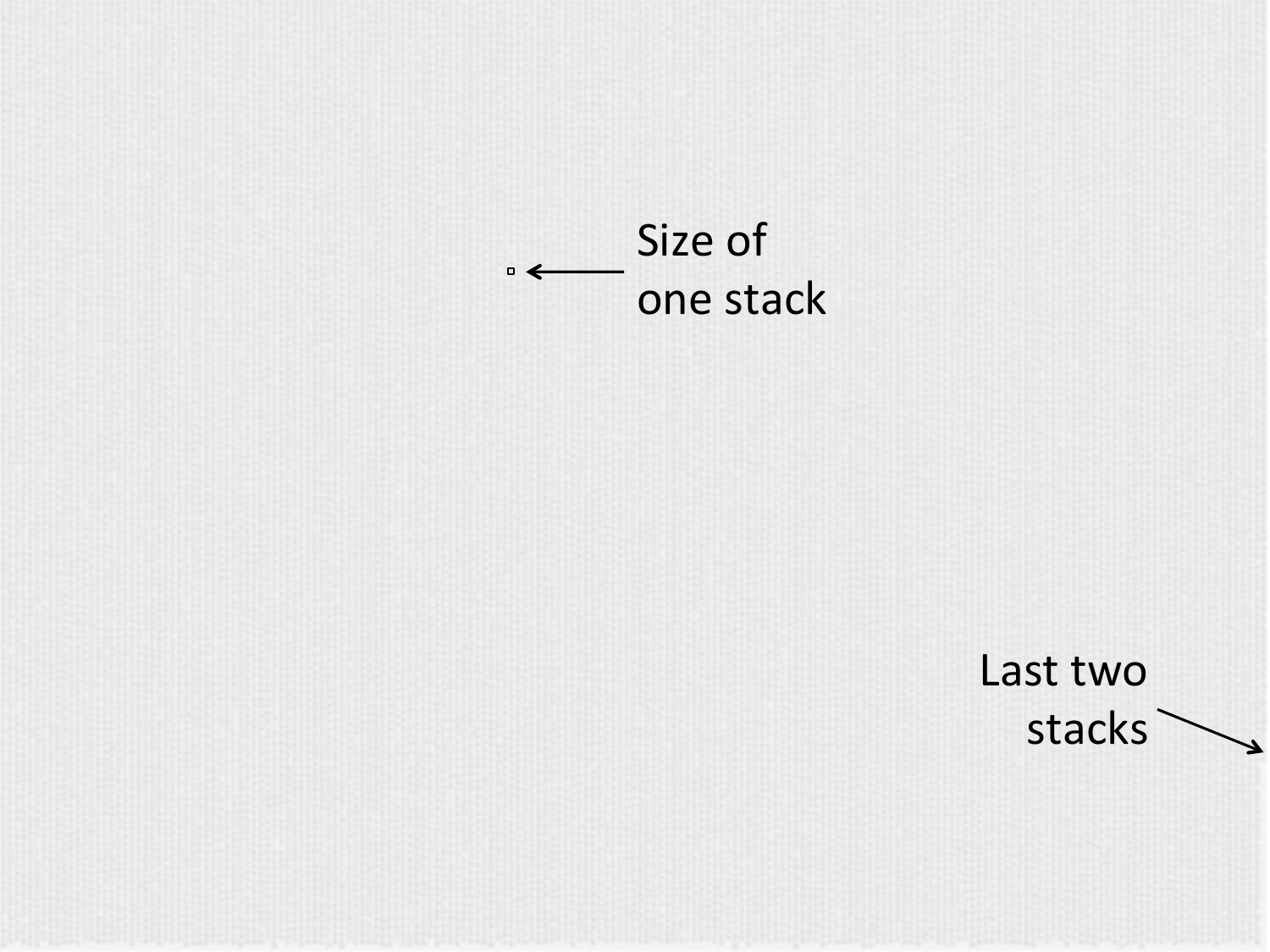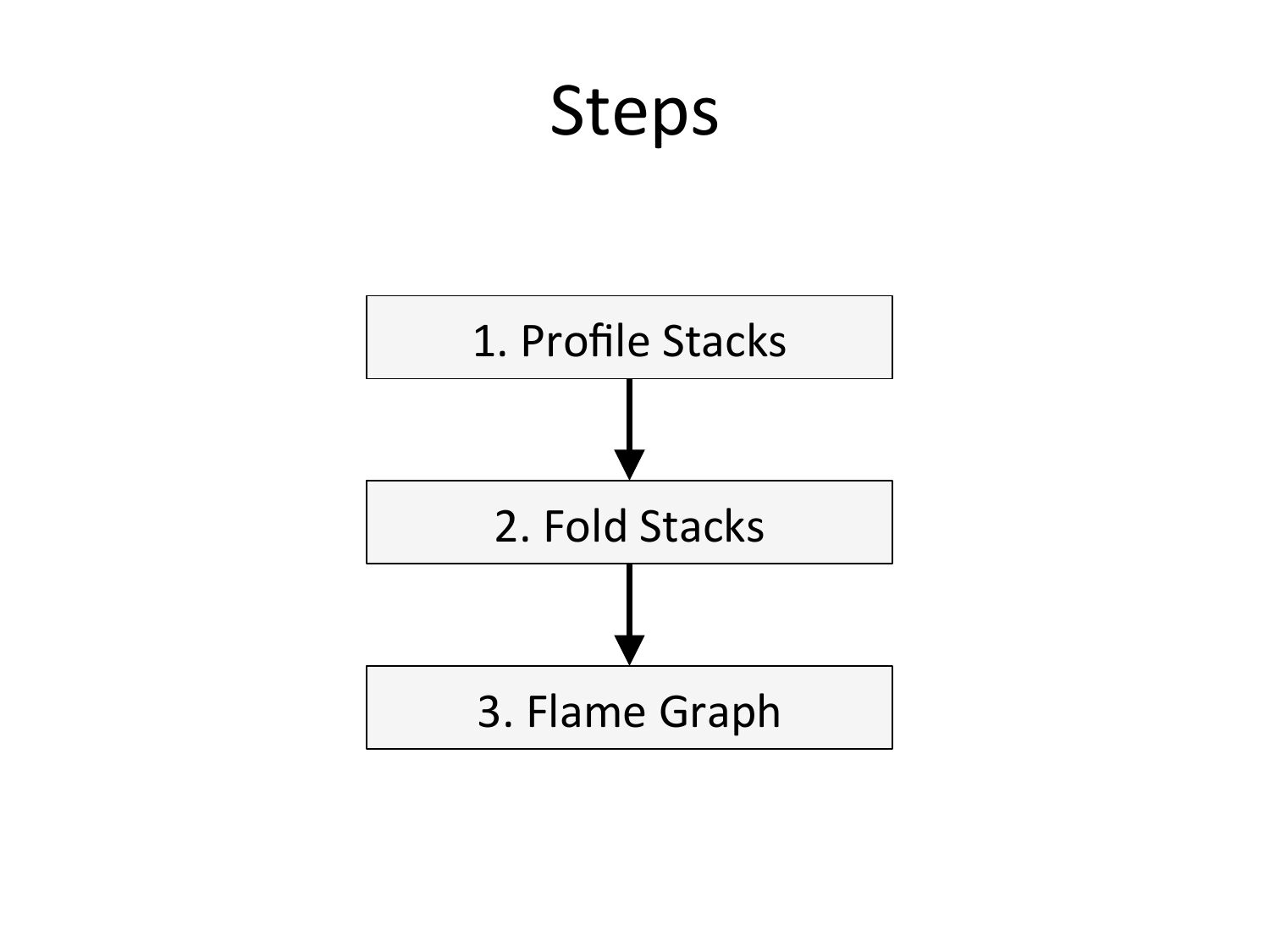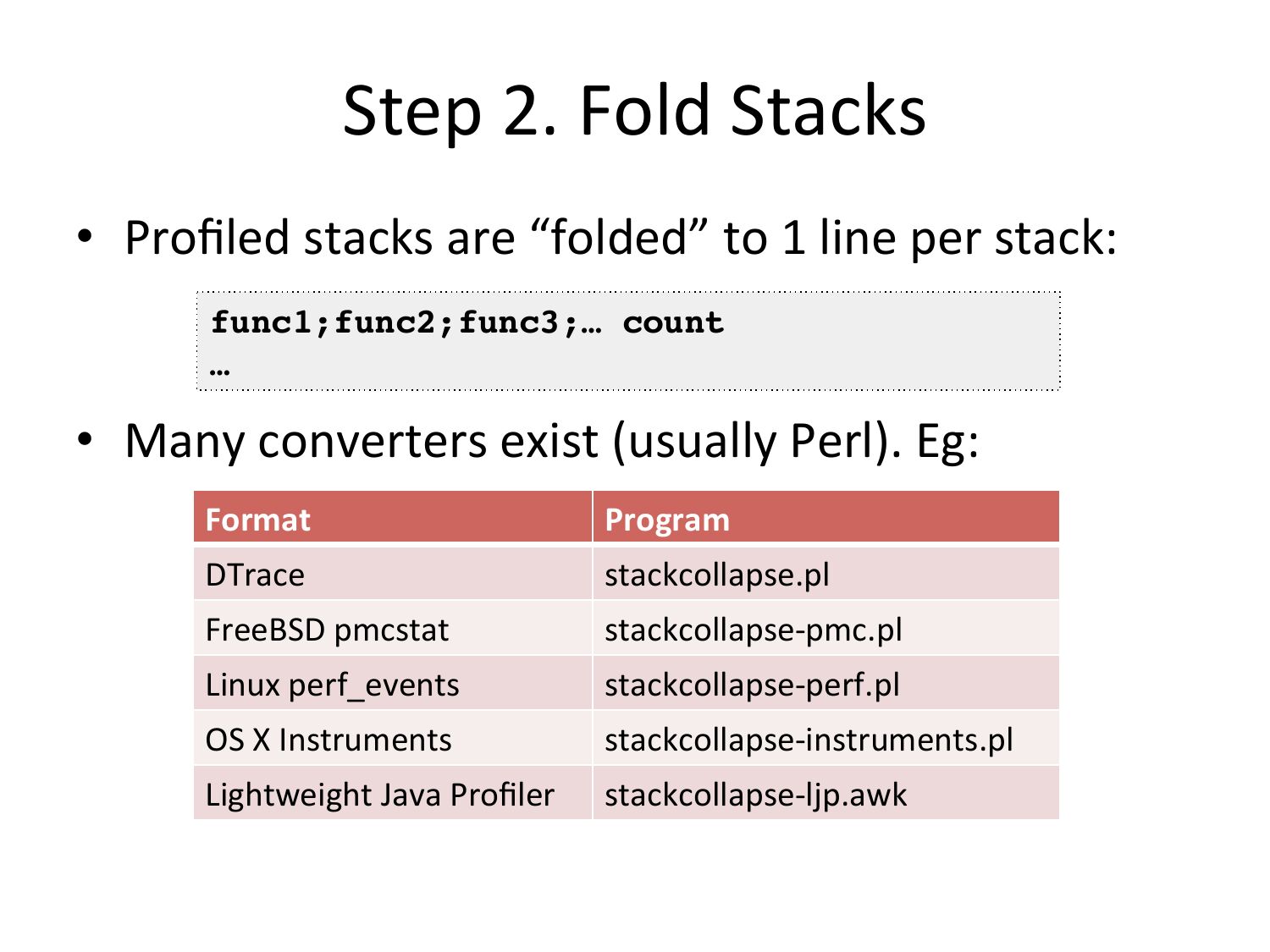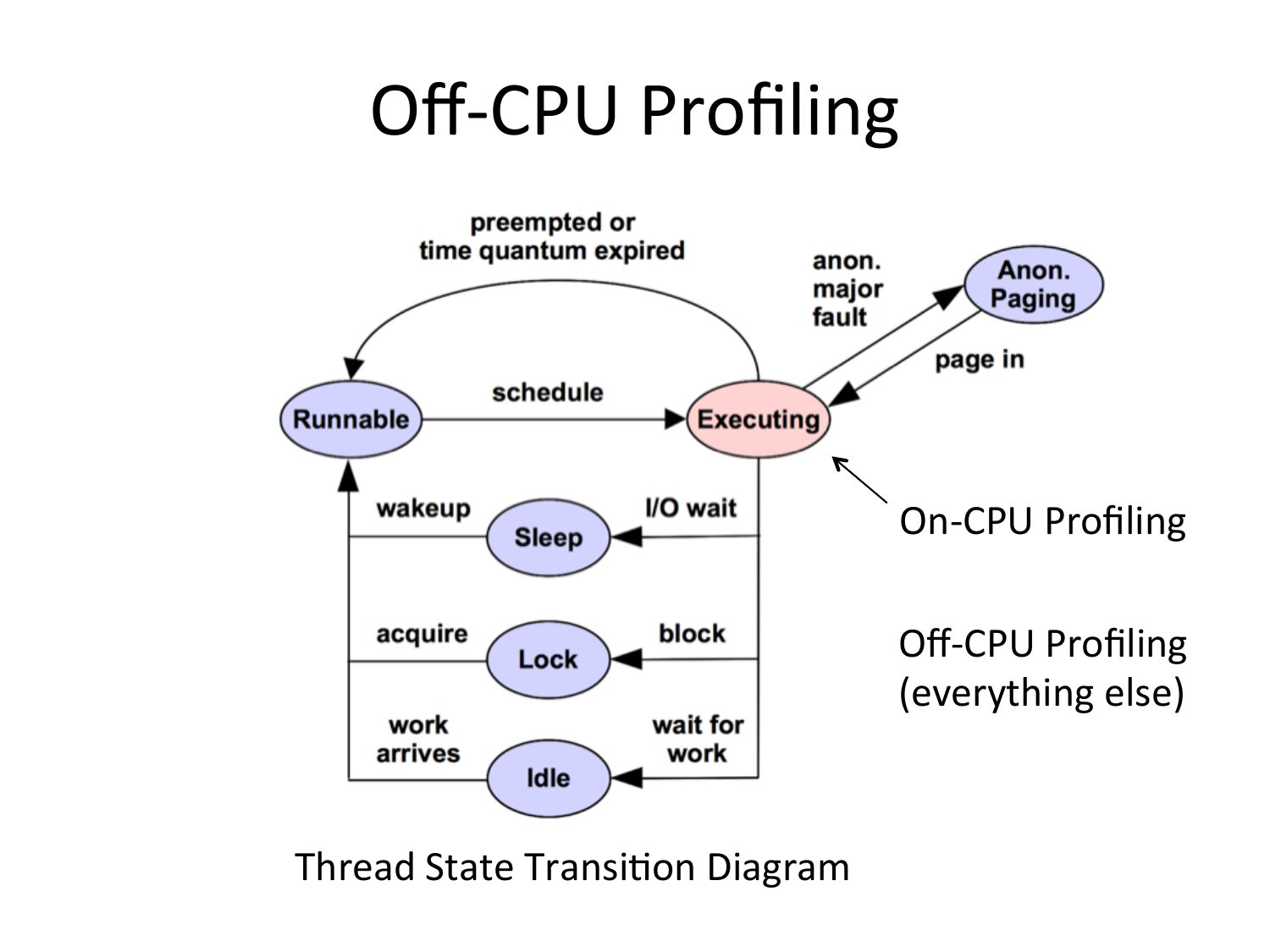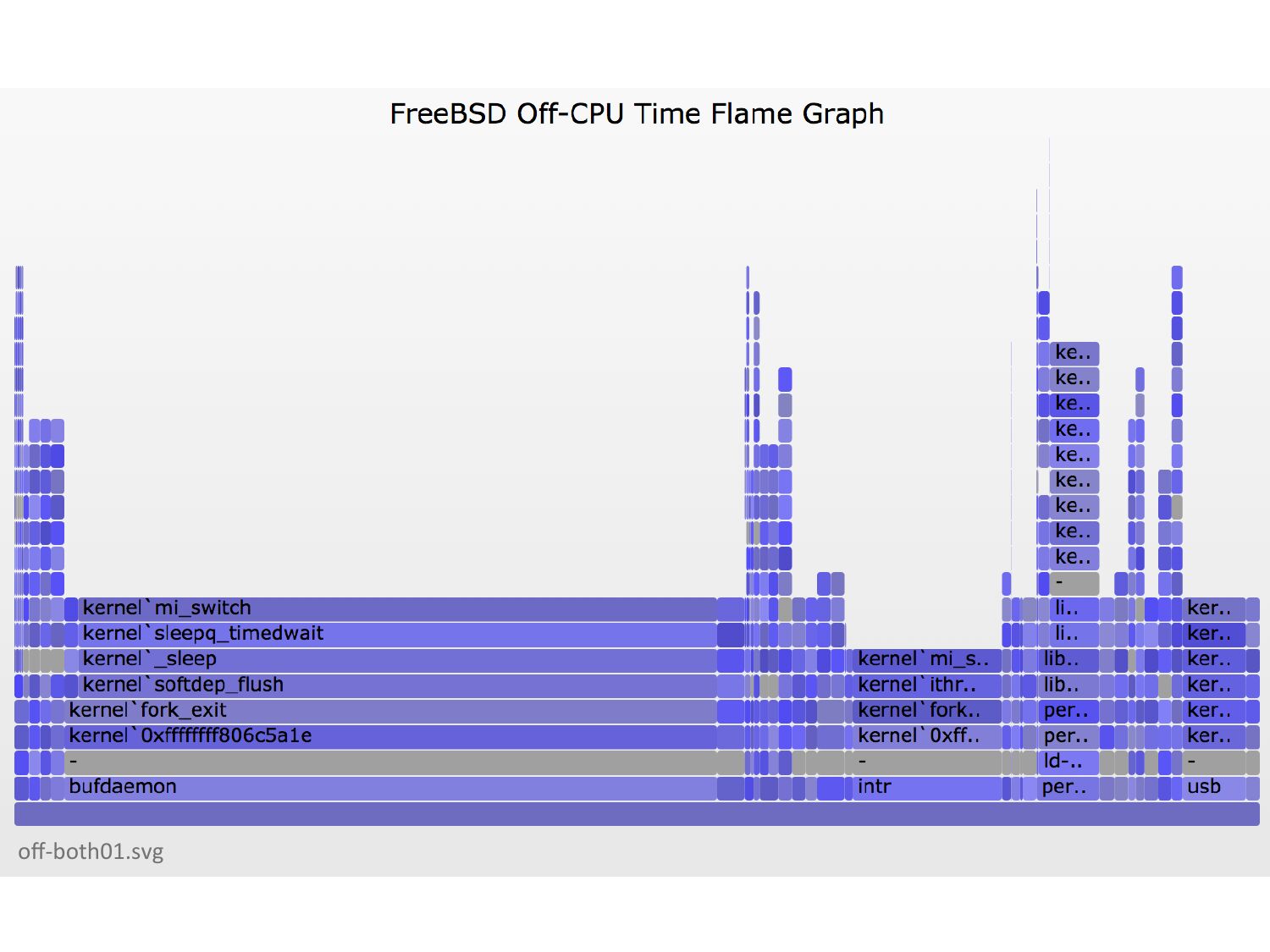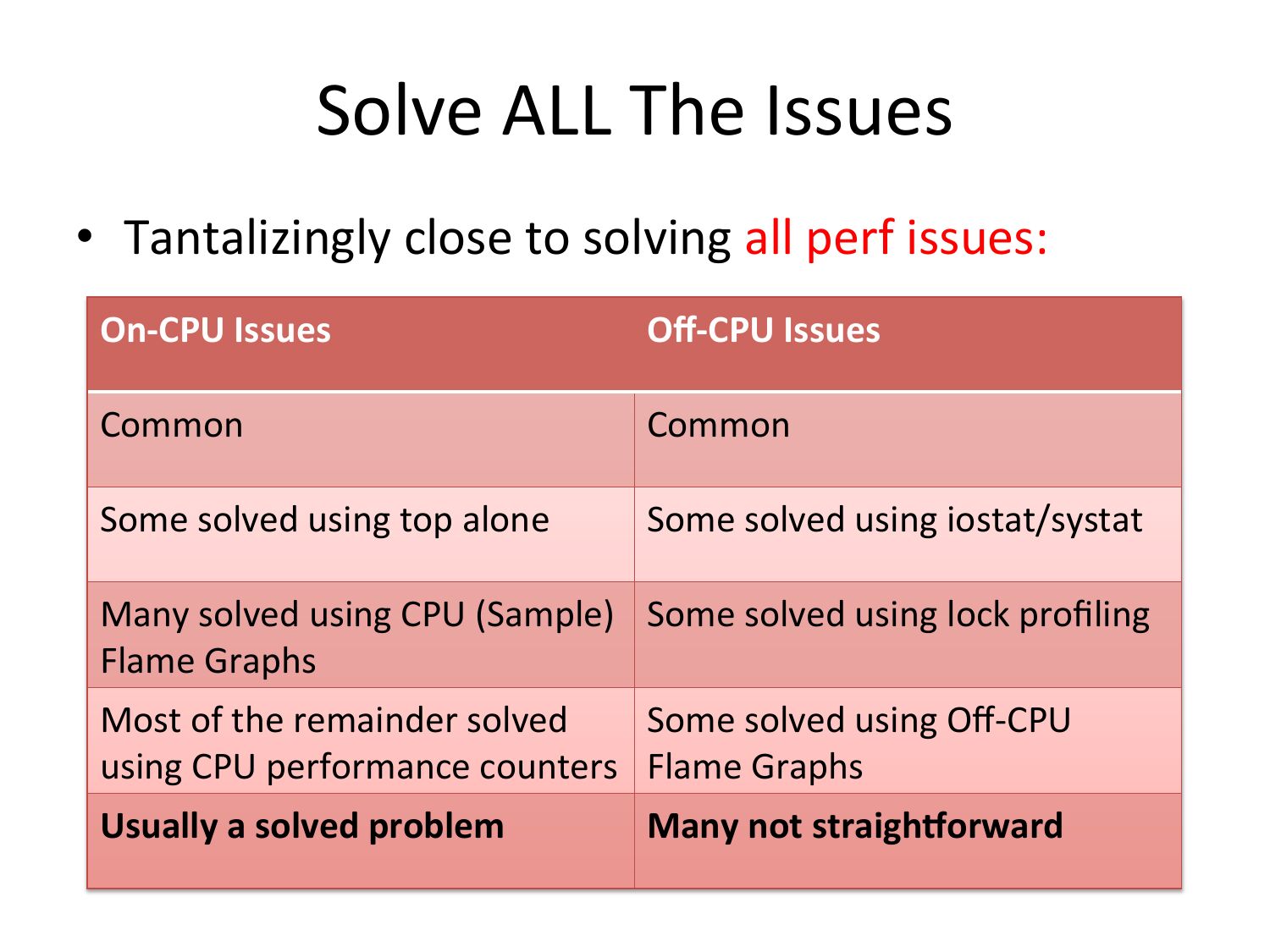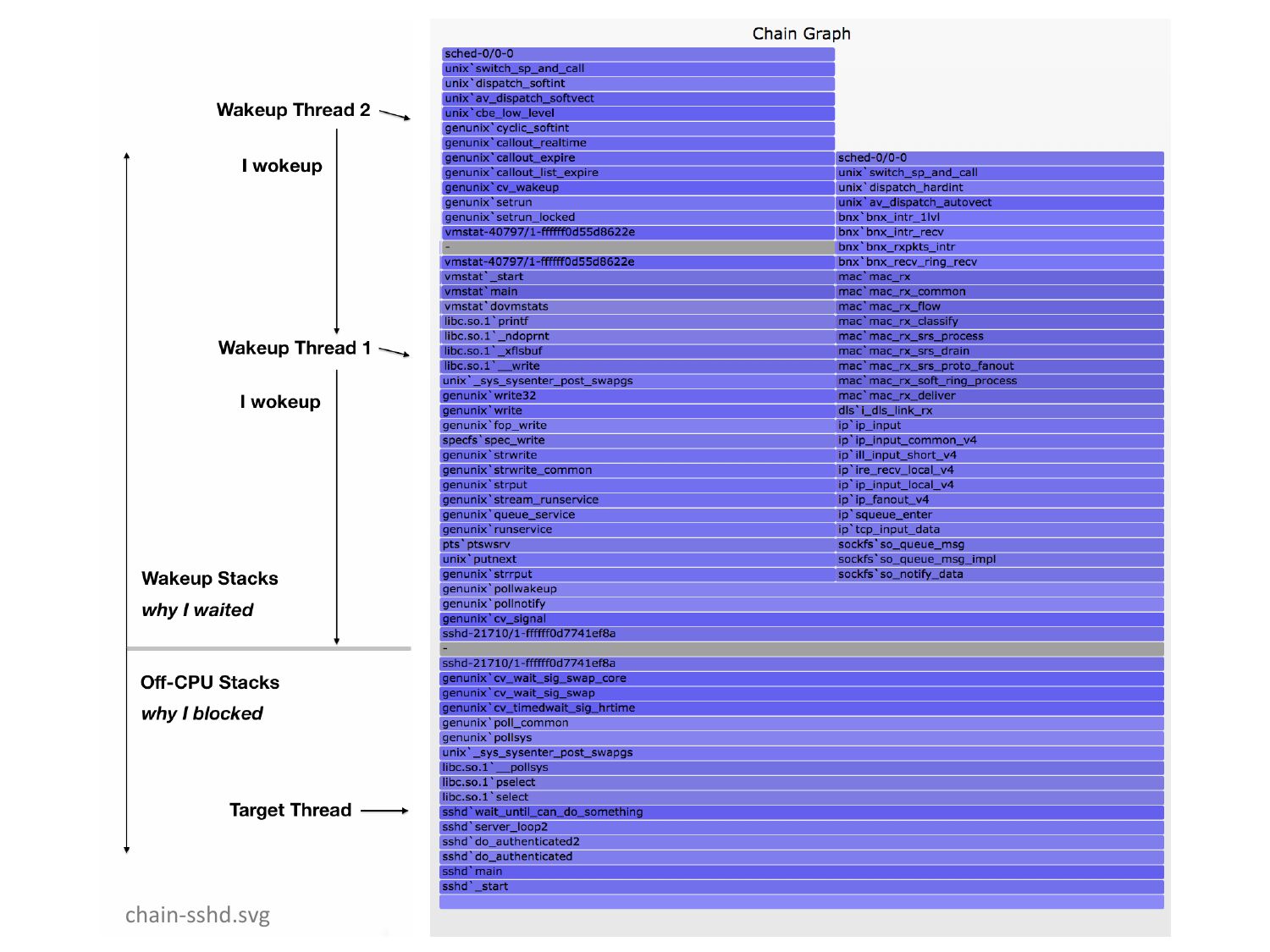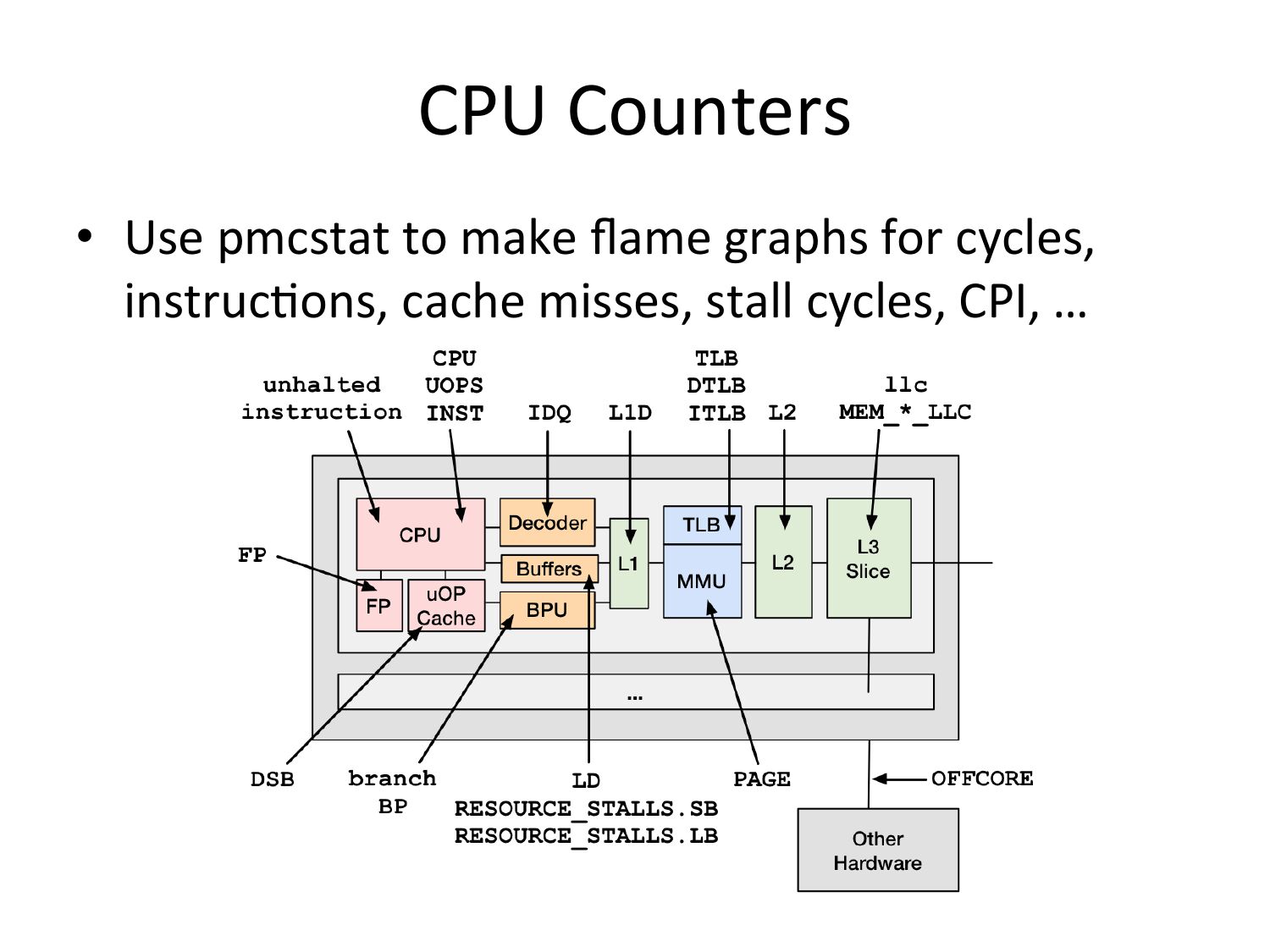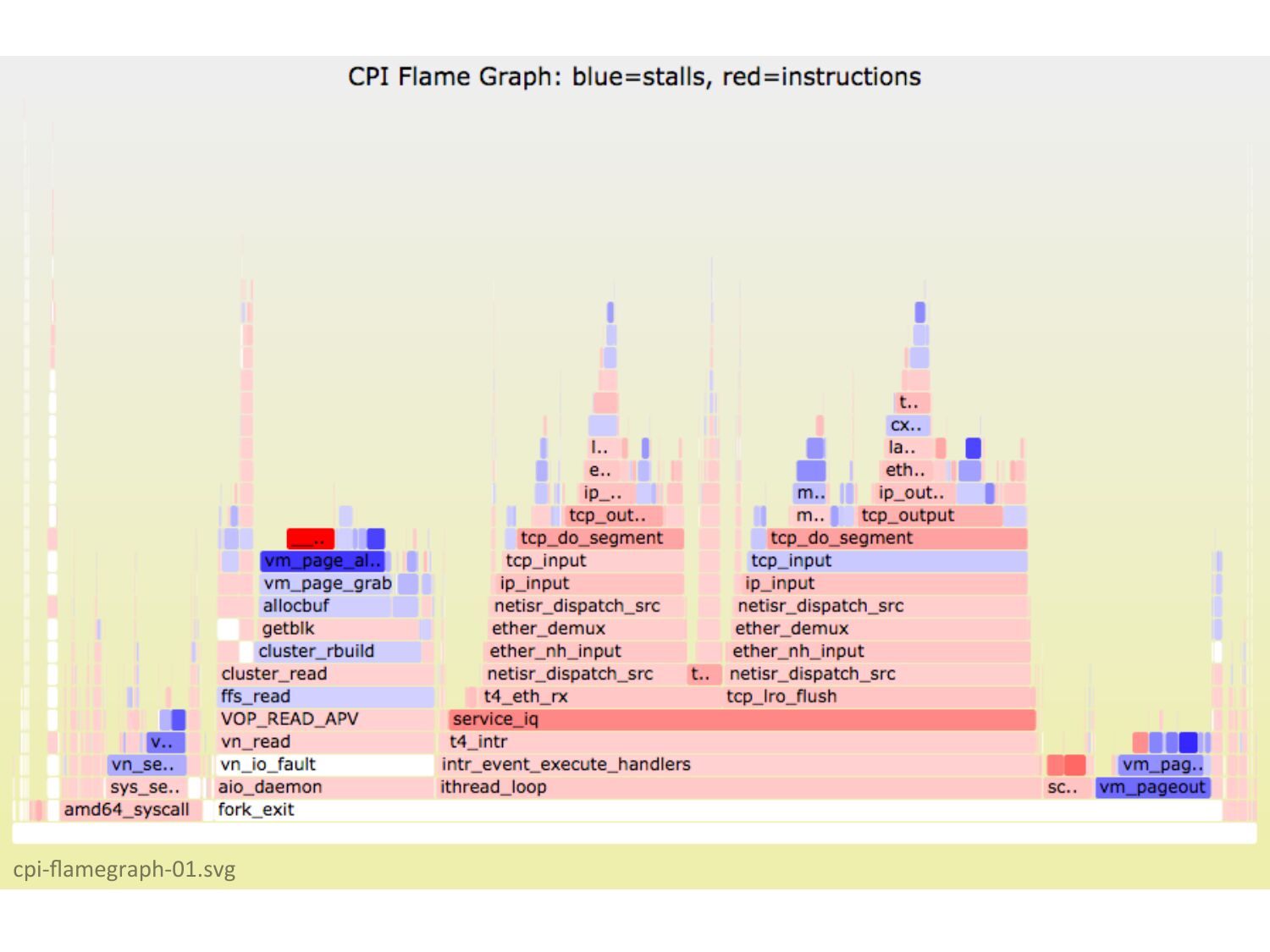FreeBSD DVS: FreeBSD 2014 Flame Graphs
Video: https://www.youtube.com/watch?v=fMV1upo88ZwTalk for the FreeBSD 2014 Dev and Vendor summit on flame graphs, by Brendan Gregg, Netflix.
| next prev 1/66 | |
| next prev 2/66 | |
| next prev 3/66 | |
| next prev 4/66 | |
| next prev 5/66 | |
| next prev 6/66 | |
| next prev 7/66 | |
| next prev 8/66 | |
| next prev 9/66 | |
| next prev 10/66 | |
| next prev 11/66 | |
| next prev 12/66 | |
| next prev 13/66 | |
| next prev 14/66 | |
| next prev 15/66 | |
| next prev 16/66 | |
| next prev 17/66 | |
| next prev 18/66 | |
| next prev 19/66 | |
| next prev 20/66 | |
| next prev 21/66 | |
| next prev 22/66 | |
| next prev 23/66 | |
| next prev 24/66 | |
| next prev 25/66 | |
| next prev 26/66 | |
| next prev 27/66 | |
| next prev 28/66 | |
| next prev 29/66 | |
| next prev 30/66 | |
| next prev 31/66 | |
| next prev 32/66 | |
| next prev 33/66 | |
| next prev 34/66 | |
| next prev 35/66 | |
| next prev 36/66 | |
| next prev 37/66 | |
| next prev 38/66 | |
| next prev 39/66 | |
| next prev 40/66 | |
| next prev 41/66 | |
| next prev 42/66 | |
| next prev 43/66 | |
| next prev 44/66 | |
| next prev 45/66 | |
| next prev 46/66 | |
| next prev 47/66 | |
| next prev 48/66 | |
| next prev 49/66 | |
| next prev 50/66 | |
| next prev 51/66 | |
| next prev 52/66 | |
| next prev 53/66 | |
| next prev 54/66 | |
| next prev 55/66 | |
| next prev 56/66 | |
| next prev 57/66 | |
| next prev 58/66 | |
| next prev 59/66 | |
| next prev 60/66 | |
| next prev 61/66 | |
| next prev 62/66 | |
| next prev 63/66 | |
| next prev 64/66 | |
| next prev 65/66 | |
| next prev 66/66 |
PDF: FreeBSD2014_FlameGraphs.pdf
Keywords (from pdftotext):
slide 1:
FreeBSD Developer and Vendor Summit, Nov, 2014 Flame Graphs on FreeBSD Brendan Gregg Senior Performance Architect Performance Engineering Team bgregg@ne5lix.com @brendangreggslide 2:
slide 3:
Agenda 1. Genesis 2. Genera=on 3. CPU 4. Memory 5. Disk I/O 6. Off-‐CPU 7. Chainslide 4:
1. Genesisslide 5:
The Problem • The same MySQL load on one host runs at 30% higher CPU than another. Why? • CPU profiling should answer this easilyslide 6:
# dtrace -x ustackframes=100 -n 'profile-997 /execname == "mysqld"/ {!
@[ustack()] = count(); } tick-60s { exit(0); }'!
dtrace: description 'profile-997 ' matched 2 probes!
CPU
FUNCTION:NAME!
1 75195
:tick-60s!
[...]!
libc.so.1`__priocntlset+0xa!
libc.so.1`getparam+0x83!
libc.so.1`pthread_getschedparam+0x3c!
libc.so.1`pthread_setschedprio+0x1f!
mysqld`_Z16dispatch_command19enum_server_commandP3THDPcj+0x9ab!
mysqld`_Z10do_commandP3THD+0x198!
mysqld`handle_one_connection+0x1a6!
libc.so.1`_thrp_setup+0x8d!
libc.so.1`_lwp_start!
4884!
mysqld`_Z13add_to_statusP17system_status_varS0_+0x47!
mysqld`_Z22calc_sum_of_all_statusP17system_status_var+0x67!
mysqld`_Z16dispatch_command19enum_server_commandP3THDPcj+0x1222!
mysqld`_Z10do_commandP3THD+0x198!
mysqld`handle_one_connection+0x1a6!
libc.so.1`_thrp_setup+0x8d!
libc.so.1`_lwp_start!
5530!
slide 7:
# dtrace -x ustackframes=100 -n 'profile-997 /execname == "mysqld"/ {!
@[ustack()] = count(); } tick-60s { exit(0); }'!
dtrace: description 'profile-997 ' matched 2 probes!
CPU
FUNCTION:NAME!
1 75195
:tick-60s!
[...]!
libc.so.1`__priocntlset+0xa!
libc.so.1`getparam+0x83!
libc.so.1`pthread_getschedparam+0x3c!
libc.so.1`pthread_setschedprio+0x1f!
mysqld`_Z16dispatch_command19enum_server_commandP3THDPcj+0x9ab!
mysqld`_Z10do_commandP3THD+0x198!
mysqld`handle_one_connection+0x1a6!
libc.so.1`_thrp_setup+0x8d!
libc.so.1`_lwp_start!
4884!
mysqld`_Z13add_to_statusP17system_status_varS0_+0x47!
mysqld`_Z22calc_sum_of_all_statusP17system_status_var+0x67!
mysqld`_Z16dispatch_command19enum_server_commandP3THDPcj+0x1222!
mysqld`_Z10do_commandP3THD+0x198!
mysqld`handle_one_connection+0x1a6!
libc.so.1`_thrp_setup+0x8d!
libc.so.1`_lwp_start!
5530!
this
stack
was
sampled
this
many
=mes
Only
unique
stacks
are
shown,
with
their
counts.
This
compresses
the
output.
slide 8:
# dtrace -x ustackframes=100 -n 'profile-997 /execname == "mysqld"/ {!
@[ustack()] = count(); } tick-60s { exit(0); }'!
dtrace: description 'profile-997 ' matched 2 probes!
CPU
FUNCTION:NAME!
1 75195
:tick-60s!
[...]!
libc.so.1`__priocntlset+0xa!
libc.so.1`getparam+0x83!
libc.so.1`pthread_getschedparam+0x3c!
libc.so.1`pthread_setschedprio+0x1f!
mysqld`_Z16dispatch_command19enum_server_commandP3THDPcj+0x9ab!
mysqld`_Z10do_commandP3THD+0x198!
mysqld`handle_one_connection+0x1a6!
libc.so.1`_thrp_setup+0x8d!
libc.so.1`_lwp_start!
4884!
mysqld`_Z13add_to_statusP17system_status_varS0_+0x47!
mysqld`_Z22calc_sum_of_all_statusP17system_status_var+0x67!
mysqld`_Z16dispatch_command19enum_server_commandP3THDPcj+0x1222!
mysqld`_Z10do_commandP3THD+0x198!
mysqld`handle_one_connection+0x1a6!
libc.so.1`_thrp_setup+0x8d!
libc.so.1`_lwp_start!
5530!
This
stack
–
the
most
frequent
–
is
slide 9:
# dtrace -x ustackframes=100 -n 'profile-997 /execname == "mysqld"/ {!
@[ustack()] = count(); } tick-60s { exit(0); }'!
dtrace: description 'profile-997 ' matched 2 probes!
CPU
FUNCTION:NAME!
1 75195
:tick-60s!
[...]!
libc.so.1`__priocntlset+0xa!
libc.so.1`getparam+0x83!
libc.so.1`pthread_getschedparam+0x3c!
libc.so.1`pthread_setschedprio+0x1f!
mysqld`_Z16dispatch_command19enum_server_commandP3THDPcj+0x9ab!
mysqld`_Z10do_commandP3THD+0x198!
mysqld`handle_one_connection+0x1a6!
libc.so.1`_thrp_setup+0x8d!
libc.so.1`_lwp_start!
4884!
mysqld`_Z13add_to_statusP17system_status_varS0_+0x47!
mysqld`_Z22calc_sum_of_all_statusP17system_status_var+0x67!
mysqld`_Z16dispatch_command19enum_server_commandP3THDPcj+0x1222!
mysqld`_Z10do_commandP3THD+0x198!
mysqld`handle_one_connection+0x1a6!
libc.so.1`_thrp_setup+0x8d!
libc.so.1`_lwp_start!
5530!
Despite
the
terse
output,
I
elided
over
500,000
lines
Here
is
what
all
the
output
looks
like…
slide 10:
slide 11:
Size
of
one
stack
Last
two
stacks
slide 12:
These
are
just
the
unique
stacks.
I
have
to
compare
this
grey
featureless
square,
with
a
grey
square
from
the
other
host,
and
explain
the
30%
CPU
difference.
And
I
need
to
do
this
by
Friday.
slide 13:
Flame
Graph
of
the
same
data
slide 14:
Flame
Graph
of
the
same
data
stack
depth
number
of
samples
one
stack
sample
slide 15:
Problem
Solved
• Comparing
two
flame
graphs
was
trivial
– MySQL
codepath
difference
suggested
different
compiler
op=miza=ons,
which
was
confirmed
• Flame
graph
needed
in
this
case
– Profile
data
was
too
large
to
consume
otherwise
– Not
always
the
case:
the
profiler
output
might
be
small
enough
to
read
directly.
For
CPU
profiles,
it
ofen
isn’t.
slide 16:
Flame
Graphs:
Defini=on
• Boxes:
are
func=ons
– Visualizes
a
frame
of
a
stack
trace
• y-‐axis:
stack
depth
– The
top
func=on
led
to
the
profiling
event,
everything
beneath
it
is
ancestry:
explains
why
• x-‐axis:
spans
samples,
sorted
alphabe=cally
– Box
width
shows
sample
count:
bigger
for
more
– Alphabe=cal
sort
improves
merging
of
like-‐frames
• Colors:
either
random
or
a
dimension
– Random
helps
separate
columns
slide 17:
Flame
Graphs:
Presenta=on
• All
threads
can
be
shown
in
the
same
graph
– So
can
mul=ple
distributed
systems
• Can
be
interac=ve
– Mouse
over
for
details
– Click
to
zoom
• Can
be
invented
– Eg,
Facebook’s
icicle-‐like
flame
graphs
• Uses
for
color:
– Differen=als
– Modes:
user/library/kernel
slide 18:
2.
Genera=on
slide 19:
Examples
• Using
DTrace
to
profile
kernel
CPU
usage:
git clone https://github.com/brendangregg/FlameGraph!
## cd
FlameGraph!
# kldload dtraceall
# if needed!
# dtrace -x stackframes=100 -n 'profile-197 /arg0/ {!
@[stack()] = count(); } tick-60s { exit(0); }' -o out.stacks!
# ./stackcollapse.pl out.stacks | ./flamegraph.pl >gt; out.svg!
• Using
pmcstat
to
profile
stall
cycles:
… !
# pmcstat –S RESOURCE_STALLS.ANY -O out.pmcstat sleep 10!
# pmcstat -R out.pmcstat -z100 -G out.stacks!
# ./stackcollapse-pmc.pl out.stacks | ./flamegraph.pl >gt; out.svg!
slide 20:
Steps
1.
Profile
Stacks
2.
Fold
Stacks
3.
Flame
Graph
slide 21:
Step
1.
Profile
Stacks
• FreeBSD
data
sources:
– DTrace
stack()
or
ustack()
– pmcstat
-‐G
stacks
– Applica=on
profilers
– Anything
that
can
gather
full
stacks
slide 22:
Step
2.
Fold
Stacks
• Profiled
stacks
are
“folded”
to
1
line
per
stack:
func1;func2;func3;… count!
• Many
converters
exist
(usually
Perl).
Eg:
Format
Program
DTrace
stackcollapse.pl
FreeBSD
pmcstat
stackcollapse-‐pmc.pl
Linux
perf_events
stackcollapse-‐perf.pl
OS
X
Instruments
stackcollapse-‐instruments.pl
Lightweight
Java
Profiler
stackcollapse-‐ljp.awk
slide 23:
Step
3.
Flame
Graph
• flamegraph.pl
converts
folded
stacks
into
an
interac=ve
SVG
Flame
Graph
– Uses
JavaScript.
Open
in
a
browser.
USAGE: ./flamegraph.pl [options] infile >gt; outfile.svg!
!--title
# change title text!
!--width
# width of image (default 1200)!
!--height
# height of each frame (default 16)!
!--minwidth
# omit smaller functions (default 0.1 pixels)!
!--fonttype
# font type (default "Verdana")!
!--fontsize
# font size (default 12)!
!--countname
# count type label (default "samples")!
!--nametype
# name type label (default "Function:")!
!--colors
# "hot", "mem", "io" palette (default "hot")!
!--hash
# colors are keyed by function name hash!
!--cp
# use consistent palette (palette.map)!
!--reverse
# generate stack-reversed flame graph!
!--inverted
# icicle graph!
!--negate
# switch differential hues (bluegt;red)!
slide 24:
Extra
Step:
Filtering
• Folded
stacks
(single
line
records)
are
easy
to
process
with
grep/sed/awk
• For
CPU
profiles,
I
commonly
exclude
cpu_idle():
# ./stackcollapse.pl out.stacks | grep –v cpu_idle | \!
./flamegraph.pl out.folded >gt; out.svg!
• Or
click-‐to-‐zoom
slide 25:
3.
CPU
slide 26:
CPU:
Stack
Sampling
slide 27:
cpu-‐freebsd01.svg
slide 28:
cpu-‐freebsd02.svg
slide 29:
cpu-‐freebsd03.svg
slide 30:
DEMO
slide 31:
CPU:
Commands
• DTrace
kernel
stack
sampling
at
199
Hertz,
60
s:
# dtrace -x stackframes=100 -n 'profile-199 /arg0/ {!
@[stack()] = count(); } tick-60s { exit(0); }' -o out.stacks!
• DTrace
user
stack
sampling
at
99
Hertz,
60
s:
# dtrace -x ustackframes=100 -n 'profile-99 /arg1/ {!
@[ustack()] = count(); } tick-60s { exit(0); }' -o out.stacks!
• Warnings:
– ustack()
more
expensive
– Short-‐lived
processes
will
miss
symbol
transla=on
slide 32:
CPU:
Commands
• DTrace
both
stack
sampling
at
99
Hertz,
30
s:
# dtrace -x stackframes=100 -x ustackframes=100 -n '!
profile-99 { @[stack(), ustack(), execname] = count(); }!
tick-30s { printa("%k-%k%s\n%@d\n", @); exit(0); }!
' -o out.stacks!
– This
prints
kernel
then
user
stacks,
separated
by
a
“-‐”
line.
flamegraph.pl
makes
“-‐”
lines
grey
(separators)
• pmcstat
for
everything
beyond
sampling
slide 33:
4.
Memory
slide 34:
Memory:
4
Targets
slide 35:
vm_faults-‐kernel01.svg
slide 36:
DEMO
slide 37:
Memory:
Commands
• DTrace
page
fault
profiling
of
kernel
stacks,
30
s:
# dtrace –x stackframes=100 -n 'fbt::vm_fault:entry {!
@[stack()] = count(); } tick-30s { exit(0) }' -o out.stacks!
• Flame
graphs
generated
with
-‐-‐colors=mem
# cat out.stacks | ./stackcollapse.pl | ./flamegraph.pl \!
--title="FreeBSD vm_fault() kernel stacks" --colors=mem \!
--countname=pages --width=800 >gt; vm_faults-kernel01.svg!
• See
earlier
diagram
for
other
targets
slide 38:
Memory:
Commands
• DTrace
page
fault
profiling
of
user
stacks,
5
s:
# dtrace -x ustackframes=100 -n 'fbt::vm_fault:entry {!
@[ustack(), execname] = count(); } tick-5s { exit(0) }!
' -o out.stacks!
• Warnings:
– Overhead
for
user-‐level
stack
transla=on
rela=ve
to
number
of
unique
stacks,
and
might
be
significant
– Stacks
for
short-‐lived
processes
may
be
hex,
as
transla=on
is
performed
afer
the
process
has
exited
• See
also
other
memory
target
types
(earlier
pic)
slide 39:
5.
Disk
I/O
slide 40:
iostart01.svg
slide 41:
DEMO
slide 42:
Disk
I/O:
Commands
• Device
I/O
issued
with
kernel
stacks,
30
s:
# dtrace –x stackframes=100 -n 'io:::start {!
@[stack()] = count(); } tick-10s { exit(0) }' -o out.stacks!
• Flame
graphs
generated
with
-‐-‐colors=io
# cat out.stacks | ./stackcollapse.pl | ./flamegraph.pl \!
--title="FreeBSD Storage I/O Kernel Flame Graph" --colors=io\!
--countname=io--width=800 >gt; iostart01.svg!
• Note
that
this
shows
IOPS;
would
be
beuer
to
measure
and
show
latency
slide 43:
6.
Off-‐CPU
slide 44:
Off-‐CPU
Profiling
On-‐CPU
Profiling
Off-‐CPU
Profiling
(everything
else)
Thread
State
Transi=on
Diagram
slide 45:
off-‐kernel01.svg
slide 46:
off-‐both01.svg
slide 47:
DEMO
slide 48:
Off-‐CPU:
Commands
• DTrace
off-‐CPU
=me
kernel
stacks,
10
s:
# dtrace -x dynvarsize=8m -x stackframes=100 –n ‘!
sched:::off-cpu { self->gt;ts = timestamp; }!
sched:::on-cpu /self->gt;ts/ { @[stack()] =!
sum(timestamp - self->gt;ts); self->gt;ts = 0; }!
tick-10s { normalize(@, 1000000); exit(0); }' -o out.stacks!
• Flame
graph:
countname=ms
• Warning:
Ofen
high
overhead.
DTrace
will
drop:
dtrace: 886 dynamic variable drops with non-empty dirty list!
• User-‐level
stacks
more
interes=ng,
and
expensive
slide 49:
Off-‐CPU:
Commands
• DTrace
off-‐CPU
=me
kernel
&
user
stacks,
10
s:
# dtrace -x dynvarsize=8m -x stackframes=100 -x ustackframes=100 –n '!
sched:::off-cpu { self->gt;ts = timestamp; }
sched:::on-cpu /self->gt;ts/ {!
@[stack(), ustack(), execname] = sum(timestamp - self->gt;ts);!
self->gt;ts = 0; }!
tick-10s { normalize(@, 1000000);!
printa("%k-%k%s\n%@d\n", @); exit(0); }!
' -o out.offcpu!
• Beware
overheads
• Real
reason
for
blocking
ofen
obscured
– Need
to
trace
the
wakeups,
and
examine
their
stacks
slide 50:
Solve
ALL
The
Issues
• Tantalizingly
close
to
solving
all
perf
issues:
On-‐CPU
Issues
Off-‐CPU
Issues
Common
Common
Some
solved
using
top
alone
Some
solved
using
iostat/systat
Many
solved
using
CPU
(Sample)
Some
solved
using
lock
profiling
Flame
Graphs
Most
of
the
remainder
solved
Some
solved
using
Off-‐CPU
using
CPU
performance
counters
Flame
Graphs
Usually
a
solved
problem
Many
not
straigh=orward
slide 51:
7.
Chain
Graphs
slide 52:
Walking
the
Wakeups…
slide 53:
chain-‐sshd.svg
slide 54:
DEMO
slide 55:
Chain
Graphs:
Commands
• This
may
be
too
advanced
for
current
DTrace
– Can’t
save
stacks
as
variables
– Overheads
for
tracing
everything
can
become
serious
• My
prototype
involved
workarounds
– Aggrega=ng
off-‐CPU-‐>gt;on-‐CPU
=me
by:
• execname,
pid,
blocking
CV
address,
and
stacks
– Aggrega=ng
sleep-‐>gt;wakeup
=me
by
the
same
– Perl
post-‐processing
to
connect
the
dots
– Assuming
that
CV
addrs
aren’t
reused
during
tracing
slide 56:
Grand
Unified
Analysis
• There
are
two
types
of
performance
issues:
– On-‐CPU:
Usually
solved
using
CPU
flame
graphs
– Off-‐CPU:
Can
be
solved
using
chain
graphs
• Combining
CPU
&
chain
graphs
would
provide
a
unified
visualiza=on
for
all
perf
issues
• Similar
work
to
chain
graphs:
– Francis
Giraldeau
(École
Polytechnique
de
Montréal),
wakeup
graph
using
LTTng,
+
distributed
systems:
hup://www.tracingsummit.org/w/images/0/00/
TracingSummit2014-‐Why-‐App-‐Wai=ng.pdf
slide 57:
Other
Topics
slide 58:
Hot/Cold
Flame
Graphs
• CPU
samples
&
off-‐CPU
=me
in
one
flame
graph
– Off-‐CPU
=me
ofen
dominates
&
compresses
CPU
=me
too
much.
By-‐thread
flame
graphs
helps.
• Example
by
Vladimir
Kirillov,
adding
a
blue
frame:
slide 59:
CPU
Counters
• Use
pmcstat
to
make
flame
graphs
for
cycles,
instruc=ons,
cache
misses,
stall
cycles,
CPI,
…
slide 60:
cpi-‐flamegraph-‐01.svg
slide 61:
Differen=al
Flame
Graphs
• Just
added
(used
to
make
the
CPI
flame
graph)
• Useful
for
non-‐regression
tes=ng:
hue
shows
difference
between
profile1
and
profile2
slide 62:
Flame
Charts
• Similar
to
flame
graphs,
but
different
x-‐axis
• x-‐axis:
passage
of
=me
• Created
by
Google
for
Chrome/v8,
inspired
by
flame
graphs
• Needs
=mestamped
stacks
– Flame
graphs
just
need
stacks
&
counts,
which
is
usually
much
less
data
slide 63:
Other
Implementa=ons/Uses
• See
hup://www.brendangregg.com/flamegraphs.html#Updates
• Some
use
applica=on
profile
sources,
which
should
work
on
FreeBSD
• Thanks
everyone
who
has
contributed!
slide 64:
Other
Text
-‐>gt;
Interac=ve
SVG
Tools
• Heatmaps:
hups://github.com/brendangregg/HeatMap
slide 65:
References
&
Links
Flame
Graphs:
Ne5lix
Open
Connect
Appliance
(FreeBSD):
hup://www.brendangregg.com/flamegraphs.html
hup://www.brendangregg.com/FlameGraphs/cpuflamegraphs.html
hup://www.brendangregg.com/FlameGraphs/memoryflamegraphs.html
hup://www.brendangregg.com/FlameGraphs/offcpuflamegraphs.html
hup://www.brendangregg.com/FlameGraphs/hotcoldflamegraphs.html
hup://www.slideshare.net/brendangregg/blazing-‐performance-‐with-‐flame-‐graphs
and
hups://www.youtube.com/watch?v=nZfNehCzGdw
hups://github.com/brendangregg/FlameGraph
hup://agentzh.org/misc/slides/off-‐cpu-‐flame-‐graphs.pdf
hups://openconnect.itp.ne5lix.com/
Systems
Performance,
Pren=ce
Hall:
hup://www.brendangregg.com/sysper€ook.html
slide 66:
Thanks
• Ques=ons?
• hup://slideshare.net/brendangregg
• hup://www.brendangregg.com
• bgregg@ne5lix.com
• @brendangregg












